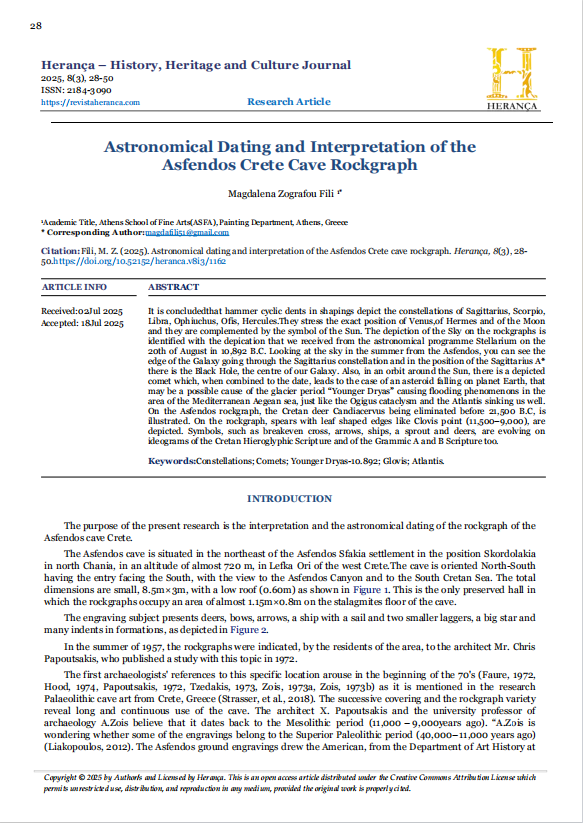Astronomical Dating and Interpretation of the Asfendos Crete Cave Rockgraph
Keywords:
Constellations; Comets; Younger Dryas-10.892; Glovis; AtlantisAbstract
It is concludedthat hammer cyclic dents in shapings depict the constellations of Sagittarius, Scorpio, Libra, Ophiuchus, Ofis, Hercules.They stress the exact position of Venus,of Hermes and of the Moon and they are complemented by the symbol of the Sun. The depiction of the Sky on the rockgraphs is identified with the depication that we received from the astronomical programme Stellarium on the 20th of August in 10,892 B.C. Looking at the sky in the summer from the Asfendos, you can see the edge of the Galaxy going through the Sagittarius constellation and in the position of the Sagittarius A* there is the Black Hole, the centre of our Galaxy. Also, in an orbit around the Sun, there is a depicted comet which, when combined to the date, leads to the case of an asteroid falling on planet Earth, that may be a possible cause of the glacier period “Younger Dryas” causing flooding phenomenons in the area of the Mediterranean Aegean sea, just like the Ogigus cataclysm and the Atlantis sinking us well. On the Asfendos rockgraph, the Cretan deer Candiacervus being eliminated before 21,500 B.C, is illustrated. On the rockgraph, spears with leaf shaped edges like Clovis point (11,500–9,000), are depicted. Symbols, such as breakeven cross, arrows, ships, a sprout and deers, are evolving on ideograms of the Cretan Hieroglyphic Scripture and of the Grammic A and B Scripture too.
Downloads
References
Anderson, D. G., Goodyear, A. C., Kennett, J., & West, A. (2011). Multiple lines of evidence for possible human population decline/settlement reorganization during the early Younger Dryas.Quaternary International, 242(2), 570–583.
Beattie, J., & Kriel, N. (2019). “Is The Starry Night Turbulent?” – Cornell Univercity.DOI:10.48550/arXiv.1902.03381.
Bradley, B., & Stanford, D. (2004). The North Atlantic ice-edge corridor: a possible Palaeolithic route to the New World.World Archaeology,36(4), 459-478. doi:10.1080/0043824042000303656
Brauer, A., Endres, C., Günter, C., Litt, T., Stebich, M., & Negendank, J. F. (1999). High resolution sediment and vegetation responses to Younger Dryas climate change in varved lake sediments from Meerfelder Maar, Germany.Quaternary Science Reviews,18(3), 321-329.
Firestone, R. B., West, A., Kennett, J. P., Becker, L., Bunch, T. E., Revay, Z. S., ... & Wolbach, W. S. (2007). Evidence for an extraterrestrial impact 12,900 years ago that contributed to the megafaunal extinctions and the Younger Dryas cooling.Proceedings of the National Academy of Sciences,104(41), 16016-16021.https://doi.org/10.1073/pnas.0706977104
Giriraj, K., & Krishna, R. (2014).Manual of Cupule Replication Technology.Rock Art Reseach, 4(3), 101-120. DOI:10.3390/arts4030101
Liakopoulos, I. (2012). Archaeologist, Asfentos Cave - Ministry of Civilization and Athletics. Retrieved from http://odysseus.culture.gr/h/2/gh251.jsp?obj_id=9929
Liritzis, I. (2010). “Strofilas (Andros, Greece): new evidence on the Cycladic Neolithic period through innovative methods of dating with the use of obsidian luminescence and hydration”.Journal of Archaeological Science,37(6), 1367-1377. https://doi.org/10.1016/j.jas.2009.12.041
Napier, W. M. (2010).Palaeolithic extinctions and the Taurid Complex. Monthly Notices of the Royal Astronomical Society, 405(3), 1901-1906. Doi:10.1111/j.1365-2966.2010.16579.x
Ocobock, C., & Lacy, S. A. (2024). The theory that men evolved to hunt and women evolved to gather is wrong. InGender in Cross-Cultural Perspective(pp. 5-12). Routledge.
Pino, M., Abarzúa, A. M., Astorga, G., Martel-Cea, A., Cossio-Montecinos, N., Navarro, R. X., ... & Kennett, J. P. (2019). Sedimentary record from Patagonia, southern Chile supports cosmic-impact triggering of biomass burning, climate change, and megafaunal extinctions at 12.8 ka.Scientific reports,9(1), 4413.
Strasser, T. F., Murray, S. C., van der Geer, A., Kolb, C., & Ruprecht Jr, L. A. (2018). Palaeolithic cave art from Crete, Greece.Journal of Archaeological Science: Reports,18, 100-108.
Sweatman, B, M., & Tsikritsis, D. (2017). Decoding Göbekli Tepe with archaeoastronomy: What does the fox say?.Mediterranean Archaeology and Archaeometry (MAA), 17(1), 233-250.

Downloads
Published
How to Cite
Issue
Section
License
Copyright (c) 2025 Herança

This work is licensed under a Creative Commons Attribution 4.0 International License.






8.png)





